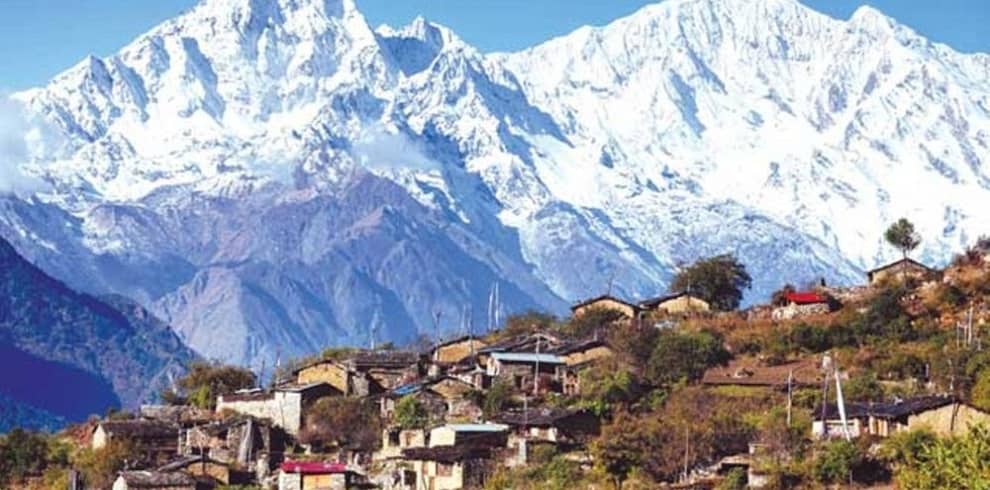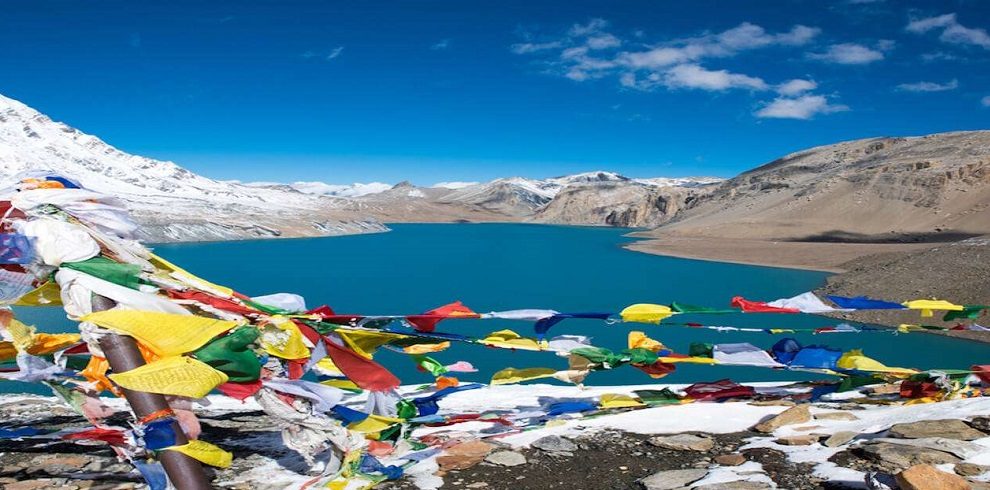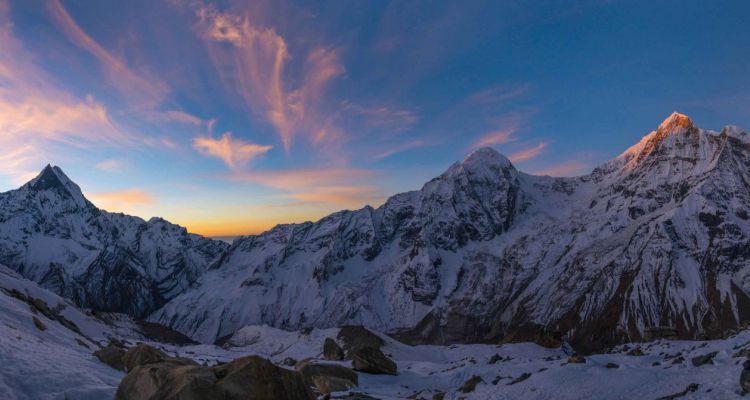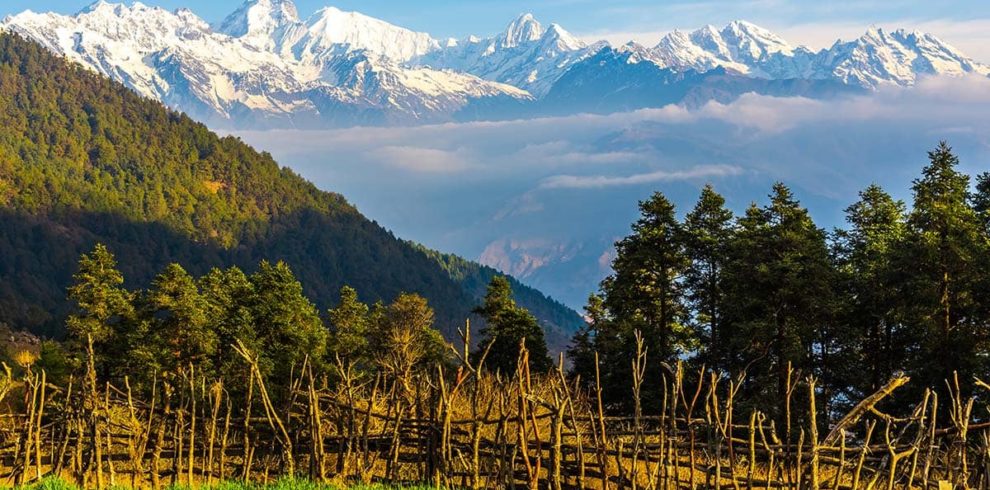Introduction To Manaslu Tsum Valley Trek In Nepal
The Manaslu Tsum Valley Trek path allows you to explore the Manaslu Circuit and Tsum Valley, which are both geographically and culturally fascinating.
Magnificent mountain vistas, dramatic landscapes, terraced slopes, intriguing canyons, Tibetan culture, and the Larkya La High Pass are among the highlights of the trek.
Upstream regions of the Budhi Gandaki River will be seen, with views of Ganesh Himal, Singri Himal, and Boudha Himal as far as Mu Gompa (3,700m).
Your journey will take you through Larkya La Pass (5,106m/16,751ft), the trek’s highest point. You will have completed a semi-circular journey around three Manaslu peaks when you arrive at the Marsyangdi river.
The Manaslu region can be seen of as Nepal’s Himalayan secret treasure, waiting to be discovered.
Tsum Valley is a Shangri-La of the Himalayas, with its rich cultural legacy and hidden mountaintop monasteries, traditional villages, colorful inhabitants, mysterious yaks, mani walls, chortens, lively festivals, and historical treasures.
The trek begins in Sotikhola and ascends the Budhi Gandaki valley through pine and rhododendron forest before ascending over a mountain to Lokpa, the Tsum valley’s entrance.
However, getting to Lokpa will take three days. We’ll start ascending from Soti Khola and halt at Machha Khola on the first day, then Jagat, and finally Lokpa on the second day.
We climb from Lokpa to Chumling, which is famous for its three monasteries: Pango Gumba, Mani Dhungyr, and Gurwa Gumba.
We travel to Chhokangparo via Domje after spending the night in Chumling (the largest village in Tsum Valley). The spectacular views of Himalchuli and Ganesh Himal from Chhokangparo are well-known.
In the lower sections, you’ll hike from Chhokangparo in the upper inner Himalayan Valley through cool bamboo and unique rhododendron forests.
The more difficult trails take you through quiet alpine glades and rugged high mountain desert. On your way to the Nile from Chhokangparo, you’ll also stop by Piren Phu cave, the region’s most revered cave.
From the Nile, you’ll continue on to Mu Gompa, the Tsum Valley Trek‘s highest point. Then we return from Mu Gompa to Lokpa and continue on with the Manaslu Circuit Trek.
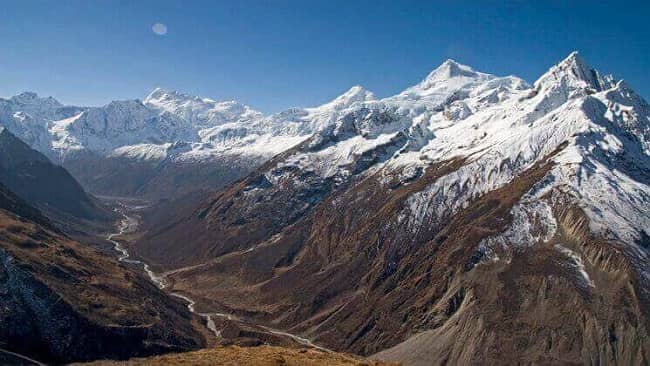
You will hike west from Lokpa to Deng for the night. You’ll pass through the villages of Ghap, Rana, and Bhiphedi along the trip. Namrung hamlet, where the locals are Tibetan descendants, is the next stop on this walk.
We leave Namrung the next day and travel to Sama Gaun. Lho is en route, and it’s full of mani wall entrance gates and Buddhist Gompas. After Lho, we hike to Sama Gaon, which is home to the Sama Gaon Monastery, via Shyala Village.
We’ll rest for a day at Sama Gaon to acclimate. You have the option of visiting Manaslu Base Camp, Birendra Lake, or Pungyen Gompa on this day.
Sama Gaon is not far from Larkya La Pass. To get to Dharmasala, all you have to do is a trek for a day. The next day, early in the morning, you’ll climb from Dharmasala to Bhimtang, passing across Larkya La Pass on the route (5,160m).
Cheo Himal, Kanguru, Himlung Himal, and Annapurna II are all visible from the pass. It is one of the Himalayas’ longest passes.
You’re almost done with this walk when you get to Bhimtang. You will hike from Bhimtang to Gho and finally to Tal.
You will take a bus or jeep from Tal to Besisahar, and then a bus from Besisahar to Kathmandu. We are confident that your Tsum Valley Trek with Manaslu Circuit will be a once-in-a-lifetime event.
Before beginning the Tsum Valley and Manaslu Circuit treks, We request that all of our valued guests stay an extra day in Kathmandu on weekdays (office days). We require at least one day to obtain a Manaslu special permit, and we require your original passport with a Nepali visa for the permit application. We’ll also utilize this time for a trip briefing, during which we’ll offer you important trip information and double-check your luggage (equipment) to ensure you haven’t forgotten anything. This journey package includes public bus transportation. A jeep can be rented for an additional fee for further comfort.
Highlights Of Manaslu Tsum Valley Trek In Nepal
- Scenic trip from Kathmandu to Tsum Valley’s Soti Khola Mu and Lungdang Gompas.
- The most sacred cave in the Tsum Valley is Milarepa Piren Phu Cave (pigeon cave).
- The oldest monasteries in the Tsum valley are Dephyudonma and Rachen monastery.
- Trek around Mt Manaslu, the world’s eighth highest peak (8,163 m).
- During the rest day at Samagaun, take a side trip to Birendra Lake, Punhyen Glacier, or Mount Manaslu Base Camp.
- Glaciers, lakes, boulders, and mountains abound on the Nepal-Tibet border, including Manasalu, Himchuli, Ganesh, and others.
- Cross the Larkya La Pass (5,106m), one of the Himalayas’ longest passes.
- Tibetan Nupri and Gurung residents have a distinct cultural mix.
- Buddhist stupas, monasteries, and the Tibetan way of life
- The trail is less congested.
- Tibet’s old trading route
Benefits Of Manaslu Tsum Valley Trek In Nepal
- A private vehicle will transport you from Tribhuvan International Airport to your accommodation for free.
- During the walk, we will store any additional luggage for free in our store.
- At high elevations, pulse oximeters are used to measure blood oxygen saturation levels. It aids in the early detection of altitude sickness.
- First-aid kit
- If you don’t have your own, sleeping bags and down jackets can be rented.
Equipment list for Tsum Valley Manaslu Circuit Trek
For Tsum Valley and Manaslu Circuit Trekking, we recommend the following apparel, gear, and equipment. This is merely a collection of reminders that we’ve compiled for your convenience. Because your luggage weight limit is 9 kilograms, please pack only what you need for the trip.
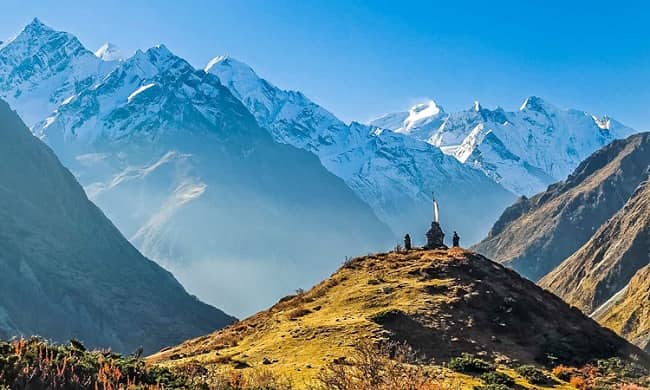
Head
- Scarf or hat for the sun
- Winter hat, insulating hat, or a hat with a wide brim
- Extra batteries for the headlight
Face
- Sunscreen
- Sunglasses that block UV rays
- Wipes for the face and body
Hands
-
Lightweight gloves
-
Heavyweight winter gloves
Body
- Shirts for hiking
- Shirt with a long sleeve made of synthetic fiber.
- Rain jacket with hood
- Jacket made of fleece
- Cotton pants that are light and airy.
- T-shirt (bring lightweight wool)
- Underwear made of polypropylene
- Jacket with down feathers (available for rent in Kathmandu)
- Sweater
- Jacket and pants that are waterproof
Footwear
- Boots for Hiking
- Socks made of thick wool (Take an extra pair of thick light socks)
Essential gear
- A daypack or a backpack (Size depends on whether you take a porter or not)
- Bottle with a heating element
- Purification of water
- Pole for hiking
- Bag for sleeping (-15 degree bag is best for high altitude trekking)
Toiletries
- a drying towel of medium size
- Toothbrush
- Toothpaste
- Deodorant/floss/toilet paper
- Biodegradable soap in a bar
- a pair of nail clippers
- Mirror, little
Personal accessories
-
Money
-
Watch
-
Cell phone
-
Camera
Extra items
- Kit for first aid
- Extra passport pictures and passport photocopies
- Pencil and notebook
- Binoculars
Manaslu Tsum Valley Hike Trip Information
Tsum Valley and Manaslu Circuit Trek Start
At least two days prior to the trek, you will arrive in Kathmandu. Please ensure that you have one extra office day (weekday) available prior to the trip’s departure date. We’ll need one day to get special permission for the Manaslu trek, and we’ll need your passport with a Nepal visa to apply for it.
Meanwhile, we’ll do a trek briefing, which will include a guide introduction and a luggage check. We drive from Kathmandu to Sotikhola, the trek’s starting site, on the third day.
The package includes local transportation (KTM via Arughat to Soti Khola, then Tal to Besisahar, and back to Kathmandu). A private jeep can be rented for an additional fee.
Free Airport Pick Up
For valued clients who have booked a package with us, we provide complimentary airport arrival and departure transfers. At the airport, our agent will be holding a leaflet with your name on it. They will greet you and give you a marigold garland or khada as a welcome gesture before driving you to your accommodation in a private vehicle.
We ask that all of our valued clients arrive in Kathmandu by 3 p.m. at least one day prior to the trip departure date. We need time to conduct a trip briefing, during which we offer you information on your journey and inspect your equipment (luggage) to ensure that you are well prepared for the walk.
Accommodation details during The Tsum Valley Trek Tour
Tsum Valley with Manaslu Circuit Trek comprises 18 nights of lodge-to-lodge stays in trek districts at the best available lodges. Three nights at a hotel in Kathmandu are required before and after the hike but are not included in the package. There are hotels in Kathmandu to suit all budgets and inclinations.
For an additional fee, hike regions offer hot showers and Wi-Fi.
Meals on Manaslu Tsum Valley Trek Itinerary
The Tsum Valley Trek takes place at high altitudes near the world’s eighth highest peak, which means your body will require adequate glycogen, protein, and other nutrients. In trek locations, you will have access to sufficient nutritional food, but your options will be limited.
During the walk, we serve 19 breakfasts, 19 lunches, and 18 dinners.
The following are some of the most popular menu items:
Oatmeal, Corn Flakes, French toast with jam, butter, and cheese, Honey Tibetan bread or Chapati, and local Tsampa porridge are among the 19 breakfast options. Eggs, pancakes, muesli bread, fruits and vegetables, and hot beverages (varieties of teas and coffees, hot chocolates, etc.)
Dhal, Bhat, Tarkari, Tibetan Bread, Soups, Momo (dumplings), Macaroni meals, Tenduk Spaghetti Noodles, Thukpa, Pasta, Vegetable curry, Potatoes, Vegetables, Salad Pizza (Tomato, Mushroom, Mixed), Snacks (Papad, Prawn), Desserts (Rice Pudding, Apple Pie), etc.
Eighteen Dinners – Dhal, Bhat, Tarkari, Tibetan Bread, Various Soups, Sherpa Stew, Steaks, Sandwiches, Momo (dumplings), Macaroni, Tenduk Spaghetti, Noodles Thukpa, Pasta, Vegetable Curry, Potato items, Vegetable and Salad Pizza (Tomato, Mushroom, Mixed), Snacks (Papad, Prawn), Korean Raman,
We will supply you with food that is fresh, hygienic, delicious, and nutritional. The menu includes traditional, Asian, and western cuisine, however, the menu gets shorter as we move higher. At high elevations, we strongly advise you to drink liquids such as green tea, lemon tea, hot lemon, ginger tea, and garlic soup (must) in addition to fresh vegetables.
Though non-vegetarian options will be plentiful in trek locations, we do not advocate them because the meat may be unsanitary. We strongly advise you to avoid dairy, alcoholic beverages, caffeinated foods, and hot chocolates, as specialists advise against them on high-altitude climbs.
All personal costs (alcoholic, hot (tea/coffee), and cold drinks) in tea houses, lodges, or cafés are excluded from the package, with the exception of regular meals (Breakfast, Lunch, and Dinner with seasonal fruits).
Best Time for Tsum Valley and Manaslu Circuit Trek
The best months to visit Tsum Valley and walk the Manaslu Circuit are March to May and September to November.
March to May – Spring
With the Manaslu Circuit Trek, it’s the ideal season to visit Tsum Valley. Stunning views of Mt. Manaslu and regional glaciers are available during this season. Temperatures begin to rise in mid-March, and with bright skies, snow peaks are at their most beautiful.
Rhododendron blossoms blossoming in a variety of colors can be found along the pathways. By the end of March, the winter snow has melted, allowing access to the Larkya La Pass. Daytime temperatures can reach 24°C in the lower lands (from Sotikhola to Ghap) and 18°C in the upper highlands (from Lho to Bhimtang). The temperature in the highlands might dip to -4°C at night.
September to November – Autumn
The Tsum Valley and the Manaslu Circuit Trek are also best visited in the autumn. Due to the pleasant weather, this is the busiest tourist season. By the end of August, the monsoon is usually over. The weather is consistent from mid-September onwards, and the skies clear, allowing you to take in the breathtaking mountain vistas.
Autumn is also a popular trekking season for tourists because Nepali celebrations such as Dashain, Tihar, and Chhat take place during this time.
The temperature in the lowlands (from Sotikhola to Ghap) can reach 25°C, while in the highlands (from Lho to Bhimtang), it can reach 15°C. In the highlands, the temperature drops to -6 °C at night. The temperature begins to drop in December, and snowfall begins in the high alpine regions. During this time, the lodge at Dharmasala closed, and because of severe snowfall, traversing Larkya La pass is nearly impossible.
The weather in the highlands is erratic and changes frequently.
Acclimatization
A rest day in Samagaun (3530m) is included in the Tsum Valley & Manaslu Circuit Trek package to provide appropriate acclimatization and avoid the risk of acute mountain sickness.
We start the walk from Soti Khola (730 m) and hike for several days in low elevations, exploring the remote Tsum Valley before proceeding to Samagaun. It gives our bodies plenty of time to adjust to the current high-altitude environment, lowering the danger of altitude sickness.
Although altitude sickness is preventable, it can be fatal if the symptoms are ignored. Our trek leaders and guides have thorough first-aid training and significant Himalayan expertise. We employ oximeters to monitor your oxygen levels, which aids in the early detection of altitude sickness. We assure you that your well-being is in capable hands.
Your trek leader or guide will advise you on how to avoid getting altitude sickness. The ideal strategy is to take it slow and drink plenty of water – at least 4 liters every day. The only way to recover from acute altitude sickness is to descend as soon as possible.
Please keep in mind that your trek leader has the authority to either continue the trip or call a halt to the ascent dependent on the team’s general condition. It is critical to recognize that certain individuals are more vulnerable than others.
Trip Grade: Fitness level, Medical, and Health
The Tsum Valley and Manaslu Circuit trips are difficult. We visit the secluded portion of Tsum Valley and relax for a day in Samagaun 3530m before continuing on the Manaslu circuit via Larkya La Pass.
In the lower lands (below 3500m), our day-to-day trekking schedule is 5 to 7 hours, while in the high highlands (above 3500m), the trip is normally 3 to 4 hours. We’ll take many breaks to take in the breathtaking alpine scenery.
Physically, trekking at higher altitudes is more difficult than trekking at lower altitudes. Long climbs, sharp descents, and straight roads characterize this remote alpine excursion.
Previous hiking experience would be beneficial, but no technical knowledge or abilities are required. This journey can be completed by hikers who can hike for 5 to 6 hours per day at a reasonable pace while carrying a light day pack.
Longer walking hours are required on some days, so you must be relatively fit and prepared for lengthy days. Regular exercise for a couple of weeks before the vacation will improve your stamina. Please keep in mind that the fitter you are, the more enjoyable the walk will be.
To participate in the trek, all participants must be in good health and have a positive attitude, self-confidence, and tenacity. Participants with pre-existing medical concerns including heart, lung, or blood disorders should let us know before signing up for the walk.
Trekking Group/Single
A minimum of two trekkers is required for the Manaslu Circuit Trek. The group will be led by our qualified trek leader. We assign an assistant guide to groups of 12 or more. The larger your group, the greater the discount you will receive. You will not receive discounts if we form a group.
The Manaslu Climb takes place in a restricted area, and special permits are only provided to groups of at least two trekkers due to the nature of the trek. We welcome lone trekkers to our group, but we are unable to organize Manaslu Circuit treks for them.
A typical day on the Manaslu Tsum trek
Every day takes you to new destinations as you travel through beautiful landscapes and lush vegetation. You’ll be snapping pictures, touring local communities, trying new foods, and seeing high-altitude species and lifestyles while taking in the breathtaking Himalayan backdrop.
Our guide/Sherpa will accompany you on the journey, showing you around and providing you with information about the areas you will be seeing. Porters will be assigned to carry your bags.
The day begins with a nice cup of tea or coffee in the morning, followed by a hearty breakfast, before setting out on the trails between 7 and 8 a.m., depending on the length and nature of the journey. You will have lunch after three to four hours of trekking, followed by an hour of recuperation. Then we’ll continue on our way; the afternoon walk will be shorter in general. We nibble on extra dietary food after we arrive at our location. You’ll have time to explore the area before it gets dark. Dinner will be served at approximately 7 p.m.
We engage in cordial chats and review the events of the day after dinner and before going to bed. The excursion leader/guide will give you an overview of the next day’s activities. You can read books, learn Nepali phrases from the crew, watch mountaineering movies, or play games like monopoly or cards after the briefing.
How to Communicate During the Trek?
For a nominal fee, you can use the internet at the lodges, but after you reach high elevations, you’ll have to communicate via phone.
Our office will connect with all of our valued clients by Signal, WhatsApp, phone, Messenger, and other means at least once a day to ensure that they are fine, safe, and comfortable.
You might get some signals along the route, depending on the network you’re using, but they’re not particularly strong at high altitudes. In Kathmandu, though, you may easily obtain a local sim card.
In most cases, you will be able to connect to the internet at all of the lodges/hotels where you will be staying.
Wi-Fi is usually available during the walk-in lodges/lodges for an additional fee.
Extra personal expenses on trekking
In Kathmandu, the clients are responsible for their own meals and lodging. You may book them conveniently online, or we can do it for you if you want.
Similarly, you must pay for visa processing, travel insurance, beverages, trip snacks, hot and cold drinks, souvenirs, and tips to trekking crew members, among other things. Bringing cash (Dollars) and changing it to Rupees is recommended. In the Nepali market, only Rupees are accepted.
Electricity, battery recharge, water on trekking
In all lodges, electricity for camera and phone recharge is available at an additional expense. During the trip, you can either buy pre-packaged mineral water or bring boiled water with you. You will also receive a water-purifying pill.
We advise against drinking water from rivers or taps because the water may be contaminated.
Trek travel insurance
This Trek requires travel insurance. Before beginning the hike, all trekkers must produce a copy of their comprehensive travel insurance policy certificate to us. Medical and emergency repatriation must be covered, as well as helicopter rescue and evacuation costs at high altitudes (up to 6000m).
Based on the experiences of our former clients, we may recommend insurance firms to you. We do not, however, sell insurance coverage. Within a week of booking the trek, we ask that all trek participants provide us with their comprehensive insurance information. In an emergency, we’ll prepare a speedy, successful rescue using your insurance policy and other documentation you supplied us.
Before you acquire travel insurance, call your provider and double-check that it covers helicopter rescue and evacuation up to 6000 meters. Do not rely solely on the material of the insurance company’s website.
How to get a visa for Nepal?
Except for Indian nationals, all foreigners must have a valid visa to enter Nepal. At Tribhuvan International Airport and Nepal’s borders with India and Tibet, you can obtain an on-arrival visa. Visit www.immigration.gov.np. for additional details.
You’ll need a passport that’s valid for at least six months, a passport-size photo, and visa fees to apply for a visa. A 30-day visa costs $50 at the moment (to be paid in cash).
A free visa will be given to children under the age of ten. It is strongly recommended that you examine the current regulations. Visa regulations are subject to change at any time. Citizens of China and members of the South Asian Association for Regional Cooperation (SAARC) (Bangladesh, Bhutan, India, Maldives, Pakistan, and Sri Lanka) are exempt from visa fees.
Certain countries’ citizens may be denied a visa upon arrival. On-arrival visas are not available for citizens of Nigeria, Ghana, Zimbabwe, Swaziland, Cameroon, Somalia, Liberia, Ethiopia, Iraq, Palestine, and Afghanistan. If you are a citizen of one of these countries, please contact the Nepalese Embassy in your country.
Before we embark on our journey, we’ll double-check everything (luggage, equipment, etc.) during our briefing.
Currency Exchange in Nepal | USD to NPR
Nepali Rupees (NPR/Rs) are the local currency.
(1 USD = ~ Rs.124 NPR).
You can exchange major foreign currencies through local banks and legitimate money exchanges in Kathmandu and all over Thamel. Legitimate money exchanges display their ongoing exchange rates visibly to the public.
Please note – only 100 INR (Indian Rupees) and 2000 INR notes are legal in Nepal.
Despite having the security advantage of traveler’s cheques, we prefer cash exchange. It helps avoid lengthy processes and high bank commissions.
You can withdraw cash (in Rupees)from ATMs all over Kathmandu and Thamel itself. Many of these ATMs are open around the clock. The maximum withdrawal amount is 35,000 Rupees for a 500 Rupees processing fee for foreign cards.
If you use the money exchange facilities at banks and financial institutions, they impose a service charge fee of about 4% or more.
During the trek, there are no banks and money exchange services so you should exchange your money in Kathmandu, depending on how much personal expense you require. Only Nepali Rupee is accepted in trekking regions.
Most established banks in Asia will only accept foreign currency notes that are not old, torn, or faded. Please ensure that you have new, clean notes.
How much luggage can I take during the Trek?
Your luggage must not exceed 9 kilograms per trekker. One porter will be allocated to each of the two trekkers, and the total weight of their luggage should not exceed 18 kg. Our porters are never overworked.
You may, however, need to bring your own knapsack or backpack (with valuables or anything important). Carry only what you need. Excess baggage can be safely stored at your hotel or at our store for no charge.
Before we begin the journey, we will double-check everything (luggage, equipment, etc.) during our briefing.
Trek Safely
All of our clients’ safety, security, and happiness are guaranteed by us. We place the highest priority on your safety. For each trip, we will bring all of the essential gear, equipment, and first-aid kits. Our guides and leaders have completed thorough first-aid training.
If a trekker becomes ill as a result of the altitude, we will analyze the situation and keep everyone safe. In the event of an emergency, the rescue chopper will be on standby to transport you back to the lower elevation. Every team member will be together for safety during the walk, and there will be no danger of being lost in hazardous terrains.
Responsible travel
Our philosophy is to photograph the voyage while leaving only footsteps. We believe in sustainable tourism and exclusively offer eco-friendly excursions.
We collaborate with the Kathmandu Environmental Education Project (KEEP) to plan eco-friendly itineraries that satisfy the needs of both tourists and local populations in the trekking areas.
Our Crew
Our knowledgeable guide/Sherpa will accompany us on the trek to ensure your safety and comfort. Your stuff will be carried by porters.
Our members are locals from high Himalayan remote places, and they have exceptional physical endurance at high altitudes.
We value all of our employees, so we pay them well and take care of their insurance, clothing, food, and lodging throughout the trip. When our guides and porters become unwell or injured, they receive medical attention.
Only happy people can make others happy, thus we always make sure that our team members are happy. Members of our trek/expedition team have the following qualifications:
- Authorized Trekking Guide Training Certificate
- Intensive Wilderness First Aid Training
- Fluency in English and another major language
- Conservation and Biodiversity Training
- Experience with rock climbing
Tipping during trek
Tipping is optional and should be dependent on the quality of service received. A tip is an accepted and respected technique in Nepali society to express gratitude (Dhanyabad) for good service.
On the last day of the walk, the majority of our guests offer advice. The amount you tip is totally up to you, and it may be more or less based on your impression of service quality, the length of your trip, your budget, and your appreciation for their efforts.
100% Guaranteed Booking
We are a government-approved and bonded trek and tour company in Nepal. We are also members of the Nepal Mountaineering Association (NMA) and the Trekking Agency Association of Nepal (TAAN) (NMA). As a result, you may book your trek/expedition with complete trust.
As a deposit, we require 10% of the total trip cost. Within a week of booking, please send your documentation, including a copy of your passport, passport-size pictures, travel insurance policy, and arrival and departure flight information.
You can make a 10% deposit via bank transfer, western union, or online payment on our website, and the full balance when you arrive in Nepal. Cash, bank transfer, and credit cards are all acceptable methods of payment. In addition, you will receive payment choices in your email.
Last-minute Trek booking in Nepal
Even though it is always a good idea to plan ahead for your excursions. However, for those who are unable to do so, we provide a special last-minute booking option. To take advantage of this benefit, you must pay the entire trip cost 24 hours before the trek’s departure.
Even while we do our best to plan treks at any time, there is a small potential of a trek delay due to events beyond our control, such as the inability to obtain air tickets or unfavorable weather.
Can I extend my trip?
If you wish to stay in Nepal for a few days after the trip, we can arrange enjoyable activities for you, such as exploring areas in and around Kathmandu, Chitwan jungle safari, paragliding, rafting, canoeing, and so on.
Feedback
We offer a farewell meal at the end of the trek, and we will also award you with a trek completion certificate after dinner (hard copy). It’s also a great opportunity to tell us about your experience and provide us feedback.
You may also visit Nepal Tour-Cost, Distance, Itinerary, In Nepal – 10 Days
Overview of Manaslu Tsum Valley Trek
- The Tsum Valley and Manaslu Circuit circles Mount Manaslu, the world’s eighth highest peak, and passes through Larkya La Pass (5,106m/16,751ft), as well as various traditional communities and important Buddhist treasures. You’ll also go to Tsum Valley, which is located within the Manaslu Conservation Area and is home to the indigenous Tsumba people.
- The Tsum Valley leg of the journey includes roaring waterfalls and rivers, steep rocky pathways clinging to cliff faces, Gurung villages with rice and millet terraces, long and mentally challenging suspension bridges, mani walls, chortens, and other Buddhist temples.
- Tsum Valley and Manaslu Trek in this physically and culturally intriguing area reward trekkers by allowing them to discover ultimate natural and cultural history as well as experience mountain life in Tsum Valley and Manaslu.
